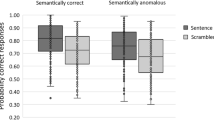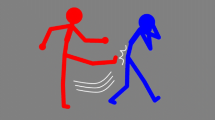Abstract
We examine the question of whether the human comprehension device exhibits word-order preferences during on-line sentence comprehension. The focus is on the positioning of finite verbs and auxiliaries relative to subjects and objects in German. Results from three experiments (using self-paced reading and event-related brain potentials) show that native speakers of German prefer to process finite verbs in second position (i.e., immediately after the subject and before the object). We will account for this order preference in terms of the relative processing costs associated with SVfO and SOVf. Our finding that word-order preferences play an important role in the on-line comprehension of German sentences is compatible with results from previous studies on English and other languages.
Similar content being viewed by others
REFERENCES
Aaronson, D., & Scarborough, H. S. (1977). Performance theories for sentence coding: Some quantitative models. Journal of Verbal Learning and Verbal Behavior, 16, 277–303.
American EEG Society. (1991). Guidelines for standard electrode position nomenclature. Journal of Clinical Neurophysiology, 8, 200–202.
Baayen, R. H., Piepenbrock, R., & van Rijn, H. (1993). The CELEX Lexical Database (CDROM). Philadelphia: Linguistic Data Consortium.
Basilico, D., Pinar, P., & Anton-Menedez, I. (1995). Canonical word order and the processing of verbal traces in Spanish. Poster presented at the Eighth Annual CUNY Conference on Human Sentence Processing, Tucson, Arizona.
Bates, E., MacWhinney, B., McNew, S., Devescovi, A., & Smith, S. (1982). Functional constraints on sentence processing: a cross-linguistic study. Cognition, 11, 245–299.
Baumann, H., Nagengast, J., & Klaas, G. (1993). New Experimental Setup (NESU). Nijmegen: MPI für Psycholinguistik.
Bayer, J., & Marslen-Wilson, W. (1992). Configurationality in the light of language comprehension: The order of arguments in German. Unpublished ms.: University of Aachen, Birkbeck College, London.
Boser, K., Lust, B., Santelmann, L., & Whitman, J. (1992). The syntax of V2 in early child German grammar: the Strong Continuity Hypothesis. In K. Broderick (Ed.), Proceedings of the Northeast Linguistic Society 23, 51–65.
Clahsen, H., Bartke, S., & Göllner, S. (1997). Formal features in impaired grammars: A comparison of English and German SLI children. Journal of Neurolinguistics, 10, 151–171.
Clahsen, H., & Featherston, S. (1999). Antecedent priming at trace positions: evidence from German scrambling. Journal of Psycholinguistic Research, 28, 415–437.
Clahsen, H., & Penke, M. (1992). The acquisition of agreement morphology and its syntactic consequences. In J. Meisel (Ed.), The acquisition of verb placement. Dordrecht: Kluwer.
Coulson, S., King, J. W., & Kutas, M. (1998). Expect the unexpected: Event-related brain response to morphosyntactic violations. Language and Cognitive Processes, 13, 21–58.
Dryer, M. S. (1991). SVO languages and the OV:VO typology. Journal of Linguistics, 27, 443–482.
Fanselow, G. (1988). German word order and universal grammar. In U. Reyle & W. Sternefeld (Eds.), Natural language parsing and linguistic theories. Dordrecht: Reidel.
Frazier, L., & Flores d'Arcais, G. (1989). Filler-driven parsing: A study of gap-filling in Dutch. Journal of Memory and Language, 28, 331–344.
Friederici, A. (1999). The neurobiology of language processing. In A. Friederici (Ed.), Language comprehension: A biological perspective. Springer: Berlin.
Friederici, A., & Mecklinger, A. (1996). Syntactic parsing as revealed by brain responses: First-pass and second-pass parsing processes. Journal of Psycholinguistic Research, 25, 157–176.
Fritzenschaft, A., Gawlitzek-Maiwald, I., Tracy, R., & Winkler, S. (1990). Wege zur komplexen Syntax. Zeitschrift für Sprachwissenschaft, 9, 52–134.
Gibson, E. (1998). Linguistic complexity: Locality of syntactic dependencies. Cognition, 68, 1–76.
Gorrell, P. (1996). Parsing theory and phrase-order variation in German V2 clauses. Journal of Psycholinguistic Research, 25, 135–156.
Grewendorf, G. (1988). Aspekte der deutschen Syntax. Tübingen: Narr.
Gunter, T., Stowe, L., & Mulder, G. (1997). When syntax meets semantics. Psychophysiology, 34, 660–676.
Günther, U. (1989). Lesen im Experiment. Linguistische Berichte, 122, 283–320.
Hagoort, P., Brown, C., & Groothusen, J. (1993). The Syntactic Positive Shift (SPS) as an ERP measure of syntactic processing. Language and Cognitive Processes, 8, 439–483.
Hahne, A., & Friederici, A. (1999). Electrophysiological evidence for two steps in syntactic analysis: early automatic and late controlled processes. Journal of Cognitive Neuroscience, 11, 194–205.
Haider, H. (1993). Deutsche Syntax-generativ. Tübingen: Narr.
Hawkins, J. (1983). Word order universals. Academic Press: London.
Hawkins, J. (1994). A performance theory of order and constituency. Cambridge: Cambridge University Press.
Hemforth, B. (1993). Kognitives Parsing: Repräsentationen und Verarbeitung grammatischen Wissens. Sankt Augustin: Infix Verlag.
Hillyard, S. A., & Picton, T. W. (1987). Electrophysiology of cognition. In F. Plum (Ed.), Handbook of physiology. Section 1: Neurophysiology. New York, American Physiological Society.
Jasper, H. (1958). The ten-twenty electrode system of the International Federation. Electroencephalography and Clinical Neurophysiology, 10, 371–375.
Just, M. A., & Carpenter, P. A. (1987). The psychology of reading and language comprehension. Boston: Allyn and Bacon.
Just, M. A., Carpenter, P. A., & Woolley, J. D. (1982). Paradigms and processes in reading comprehension. Journal of Experimental Psychology: General, 111, 228–238.
Kaan, E. (1997). Processing subject-object ambiguities in Dutch. PhD. Thesis: University of Groningen. (Groningen Dissertations in Linguistics 20).
Kathol, A. (1990). A uniform approach to V2 in German. In Proceedings of the Northeast Linguistic Society 20, 244–254.
Kayne, R. (1994). The antisymmetry of syntax. Cambridge, Mass: MIT Press.
Kluender, R., & Münte, T. (1998). ERPs to grammatical and ungrammatical subject/object asymmetries in German wh-questions. Poster presented at 11th CUNY Conference on Human Sentence Processing, Rutgers University.
Kolk, H. H. J., & Heeschen, C. (1992). Agrammatism, paragrammatism and the management of language. Language and Cognitive Processes, 7, 89–129.
Koopman, H. (1984). The syntax of verbs: From verb movement rules in the Kru languages to Universal Grammar. Dordrecht: Foris.
Kutas, M., & Van Petten, C. (1994). Psycholinguistics electrified. In M. Gernsbacher (Ed.), Handbook of psycholinguistics. New York: Academic Press.
Lehmann, W. P. (1973). A structural principle of language and its implications. Language, 49, 42–66.
Love, T., & Swinney, D. (1996). Coreference processing and levels of analysis in objectrelative constructions: Demonstration of antecedent reactivation with the cross-modal priming paradigm. Journal of Psycholinguistic Research, 25, 5–24.
Love, T., & Swinney, D. (1998). The influence of canonical word order on structural processing. Syntax and semantics, Vol. 31: Sentence processing: A crosslinguistic perspective.
MacDonald, M., Pearlmutter, N., & Seidenberg, M. (1994). The lexical nature of syntactic ambiguity resolution. Psychological Review, 101, 676–703.
MacWhinney, B., & Bates, E. (1989). The crosslinguistic study of sentence processing. Cambridge University Press: Cambridge.
MacWhinney, B., Bates, E., & Kliegl, R. (1984). Cue validity and sentence interpretation in English, German and Italian. Journal of Verbal Learning and Verbal Behavior, 23, 127–150.
Mallinson, G., & Blake, B. (1979). Language typology: Crosslinguistic studies in syntax, North-Holland: Amsterdam.
McKinnon, R., & Osterhout, L. (1996). Constraints on movement phenomena in sentence processing: Evidence from event-related brain potentials. Language and Cognitive Processes, 11, 495–523.
Mecklinger, A., Schriefers, H., Steinhauer, K., & Friederici, A. (1995). The processing of relative clauses varying in syntactic complexity and semantic plausibility: An analysis with event-related potentials. Memory & Cognition, 23, 477–494.
Meng, M. (1995). Processing wh-questions in German and Dutch: Differential effects of disambiguation and their interpretation. Poster presented at the AMLaP-95 Conference. Edinburgh, UK.
Münte, T., Matzke, M., & Johannes, S. (1998). Brain activity associated with syntactic incongruencies in words and pseudowords. Journal of Cognitive Neuroscience, 9, 318–32.
Münte, T., Urbach T., Düzel E., & Kutas, M. (2000). Event-related potentials in the study of human cognition and neuropsychology. In F. Boller, J. Grafman, & G. Rizzolatti (Eds.), Handbook of neuropsychology, Vol. 1, 2nd ed., Amsterdam: Elsevier.
Münte, T. F., Wieringa, B. M., Weyerts, H., Szentkuti, A., Matzke, M., & Johannes, S. (2001). Differences in brain potentials to open and closed class words: class and frequency effects. Neuropsychologia, 39, 91–102.
Nakano, Y., Felser, C., & Clahsen, H. (2000). Antecedent priming at trace positions in Japanese long-distance scrambling. Essex Research Reports in Linguistics, 31, 45–76.
Neville, H., Nicol, J., Barss, A., Forster, K., & Garrett, M. (1991). Syntactically based processing classes: Evidence from event-related brain potentials. Journal of Cognitive Neuroscience, 3, 151–165.
Osterhout, L., & Holcomb, P. (1992). Event-related brain potentials elicited by syntactic anomaly. Journal of Memory and Language, 31, 785–804.
Osterhout, L., Holcomb P., & Swinney, D. (1994). Brain potentials elicited by garden-path sentences: Evidence of the application of verb information during parsing. Journal of Experimental Psychology: Learning, Memory and Cognition, 20, 786–803.
Osterhout, L. (1997). On the brain response to syntactic anomalies: Manipulations of word position and word class reveal individual differences: Brain and Language, 59, 494–522.
Ostrosky-Solis, F., Rigalt, C., Perez, M., & Marcos, J. (1996). Brain-potentials (ERPs) and syntactic comprehension: Effects of thematic role order. Brain and Cognition, 30, 297–300.
Penke, M. (1998). Die Grammatik des Agrammatismus. Eine linguistische Untersuchung zu Wortstellung und Flexion bei Broca-Aphasie. Tübingen: Niemeyer.
Penke, M. (2001). Controversies about CP: A comparison of language acquisition and language impairments in Broca's aphasia. Brain and Language, 77, 351–363.
Penke, M., Weyerts, H., Gross, M., Zander, E., Münte, T., & Clahsen, H. (1997). How the brain processes complex words: An event-related potential study of German verb inflections. Cognitive Brain Research, 6, 37–52.
Phillips, C. (1996). Order and structure. Unpublished PhD. dissertation. MIT: Cambridge, MA.
Poeppel, D., & Wexler, K. (1993). The full competence hypothesis of clause structure in early German. Language, 69, 1–33.
Radford, A. (1990). Syntactic theory and the acquisition of English syntax: The nature of early child grammars of English. Oxford: Basil Blackwell.
Reis, M. (1985). Satzeinleitende Strukturen in Deutschen. Ñber COMP, Haupt-und Nebensätze, w-Bewegung und die Doppelkopfanalyse. In W. Abraham (Ed.), Erklärende Syntax des Deutschen. Tübingen: Narr.
Schmid, M. (2002). First language attrition, use and maintenance: The case of German jews in anglophone countries. Benjamins: Amsterdam. (in press)
Schwartz, B., & Vikner, S. (1996). All verb-second clauses are CPs. In A. Belleti & L. Rizzi (Eds.), Parameters and functional heads. Oxford University Press: Oxford.
Stamenow, M., & Andonova, A. (1998). Lexical access and coreference processing in Bulgarian. In D. Hillert (Ed.), Crosslinguistic studies of language processing. Academic Press: London.
Steele, S. (1975). On some factors that affect and effect word order. In C. N. Li (Ed.), Word order and word order change. Academic Press: London.
Steele, S., Akmajiam, A., Demers, R., Jelinek, E., & Kitagawa, C. (1981). An encyclopedia of Aux: A study in crosslinguistic equivalence. MIT Press: Cambridge, MA.
Thiersch, C. (1978). Topics in German syntax. Unpublished PhD. dissertation. MIT: Cambridge, MA.
Tomlin, R. (1986). Basic word order: Functional principles. London: Croom Helm.
Travis, L. (1984). Parameters and effects of word order variation. Unpublished PhD dissertation. MIT: Cambridge, MA.
Travis, L. (1991). Parameters of phrase structure and V2 phenomena. In R. Freidin (Ed.), Principles and parameters in comparative grammar. MIT Press: Cambridge, MA.
von Stechow, A., & Sternefeld, W. (1988). Bausteine syntaktischen Wissens. Opladen: Westdeutscher Verlag.
Weyerts, H., Penke, M., Dohrn, U., Clahsen, H., & Münte, T. (1997). Brain potentials indicate differences between regular and irregular German plurals. Neuroreport, 8, 957–962.
Zwart, J. W. (1993). Dutch syntax: A minimalist approach. Unpublished doctoral dissertation. University of Groningen.
Author information
Authors and Affiliations
Corresponding author
Rights and permissions
About this article
Cite this article
Weyerts, H., Penke, M., Münte, T.F. et al. Word Order in Sentence Processing: An Experimental Study of Verb Placement in German. J Psycholinguist Res 31, 211–268 (2002). https://doi.org/10.1023/A:1015588012457
Issue Date:
DOI: https://doi.org/10.1023/A:1015588012457




